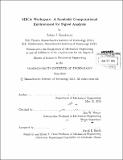| dc.contributor.advisor | Ian W. Hunter. | en_US |
| dc.contributor.author | Spanbauer, Adam J. (Adam Jeffrey) | en_US |
| dc.contributor.other | Massachusetts Institute of Technology. Department of Mechanical Engineering. | en_US |
| dc.date.accessioned | 2013-10-24T17:49:07Z | |
| dc.date.available | 2013-10-24T17:49:07Z | |
| dc.date.copyright | 2013 | en_US |
| dc.date.issued | 2013 | en_US |
| dc.identifier.uri | http://hdl.handle.net/1721.1/81727 | |
| dc.description | Thesis (S.M.)--Massachusetts Institute of Technology, Dept. of Mechanical Engineering, 2013. | en_US |
| dc.description | Cataloged from PDF version of thesis. | en_US |
| dc.description | Includes bibliographical references (p. 55-56). | en_US |
| dc.description.abstract | With initiatives such as edX beginning to spread low-cost education through the world, a question has arisen. How can we provide hands-on experience at minimal cost? Virtual online experiments are not enough. To build science and engineering skill and intuition, students must set up and run experiments with their own hands. Measurement, Instrumentation, Control, and Actuation (MICA), is a system under development at the MIT BioInstrumentation Lab. The MICA system consists of low-cost hardware and software. The hardware is a set of small, instrumentation-grade sensors and actuators which communicate wirelessly with a miniature computer. This computer hosts a web service which a user can connect to in order to control the MICA hardware and analyze the data. This web-based environment is called MICA Workspace. MICA Workspace is a numeric and symbolic environment for signal analysis. The main component is a new symbolic mathematics engine. Some features of this engine include symbolic integration and differentiation, tensor manipulation with algorithms such as singular value decomposition, expression simplification, and optimal SI unit handling. This thesis is intended to map the terrain surrounding the construction of MICA Workspace, the software part of MICA. I do not describe techniques in detail when clear and precise sources exist elsewhere. Instead, I describe the purposes and limitations of such techniques, and provide references to technical sources. | en_US |
| dc.description.statementofresponsibility | by Adam J. Spanbauer. | en_US |
| dc.format.extent | 56 p. | en_US |
| dc.language.iso | eng | en_US |
| dc.publisher | Massachusetts Institute of Technology | en_US |
| dc.rights | M.I.T. theses are protected by
copyright. They may be viewed from this source for any purpose, but
reproduction or distribution in any format is prohibited without written
permission. See provided URL for inquiries about permission. | en_US |
| dc.rights.uri | http://dspace.mit.edu/handle/1721.1/7582 | en_US |
| dc.subject | Mechanical Engineering. | en_US |
| dc.title | MICA workspace : a symbolic computational environment for signal analysis | en_US |
| dc.title.alternative | Measurement, Instrumentation, Control, and Actuation workspace : a symbolic computational environment for signal analysis | en_US |
| dc.type | Thesis | en_US |
| dc.description.degree | S.M. | en_US |
| dc.contributor.department | Massachusetts Institute of Technology. Department of Mechanical Engineering | |
| dc.identifier.oclc | 861186903 | en_US |
